Morphemes. The Structure of the English Word Lecture


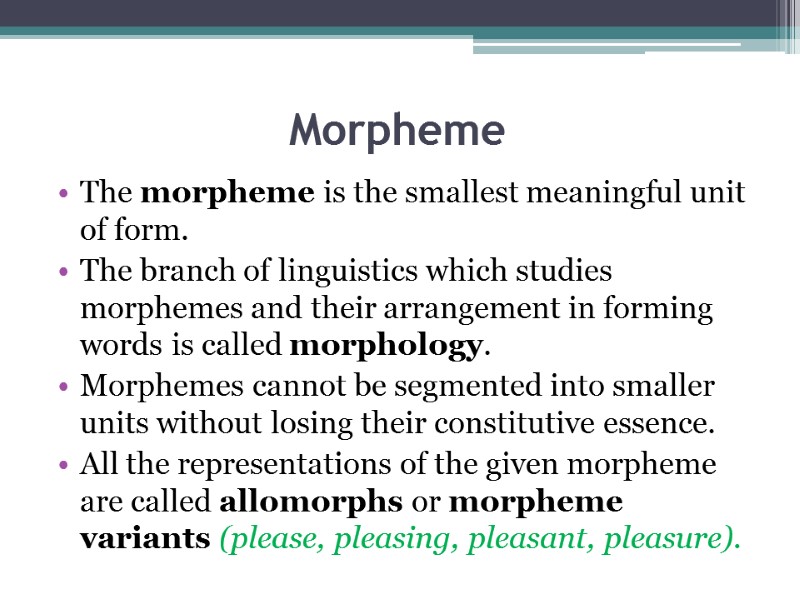
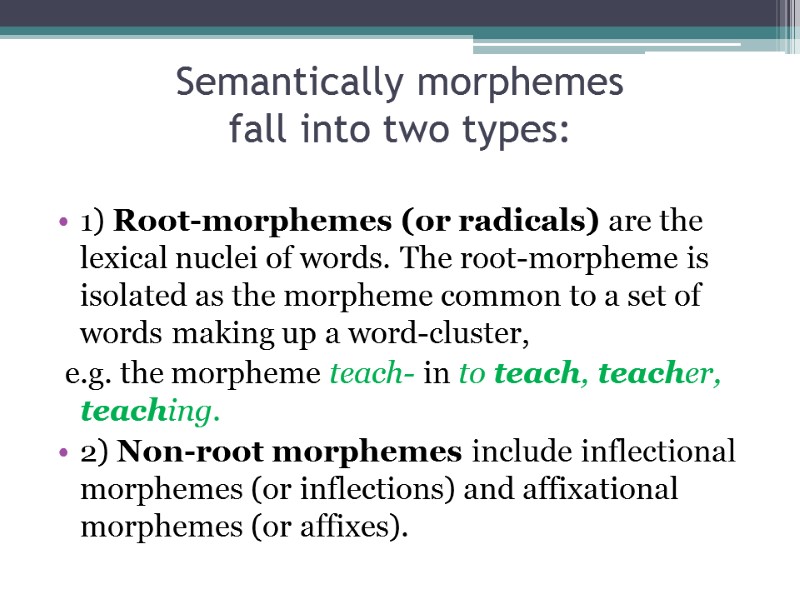
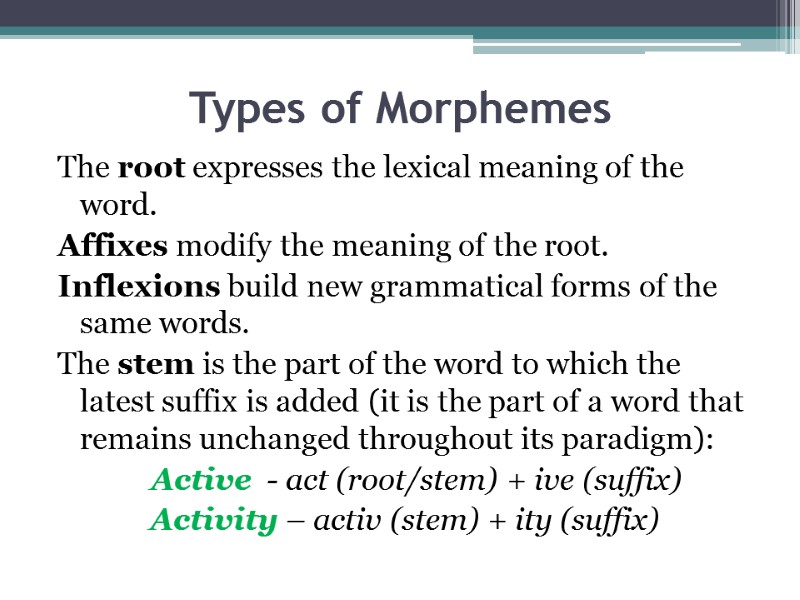
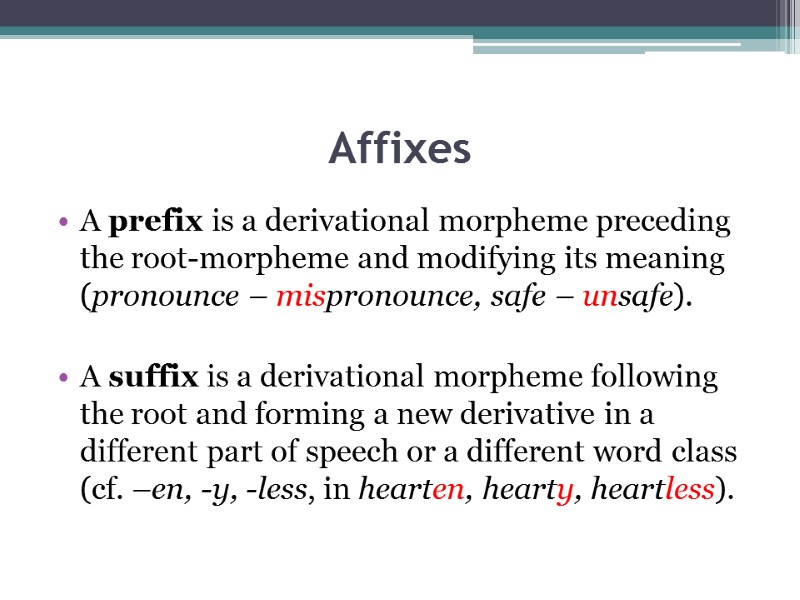
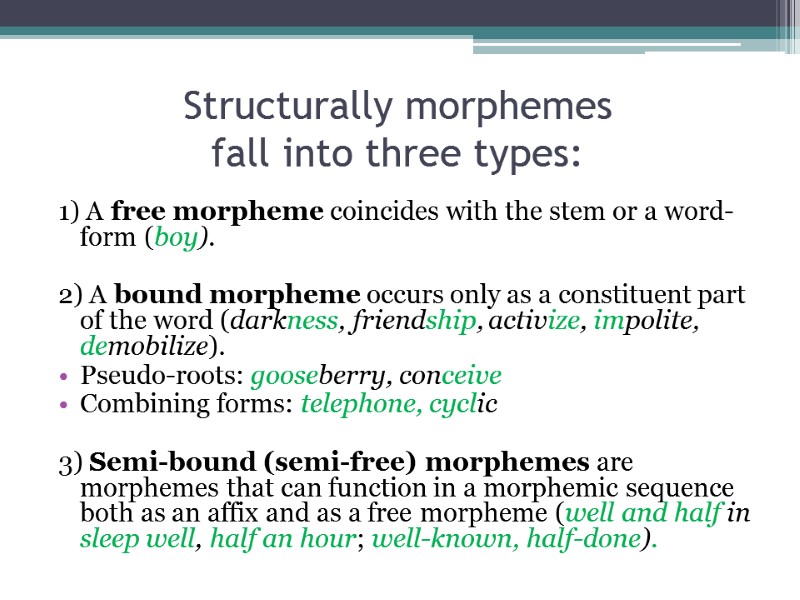
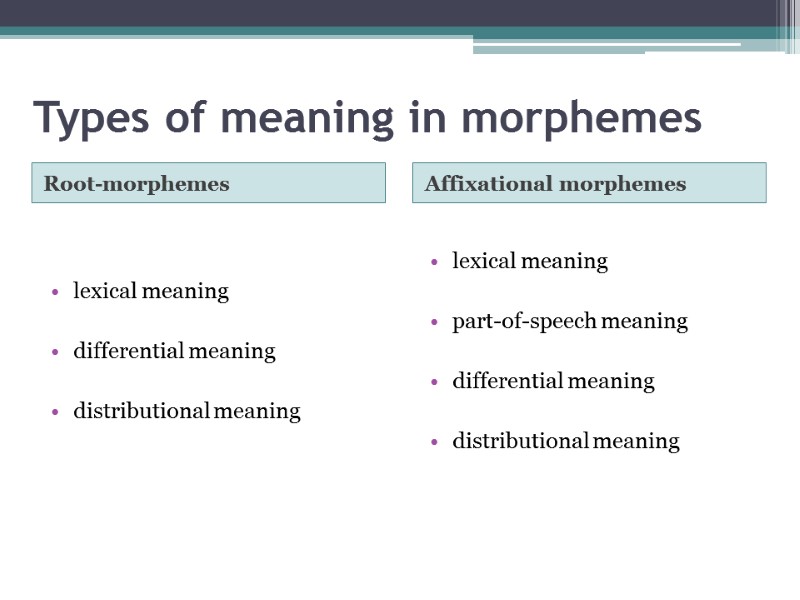
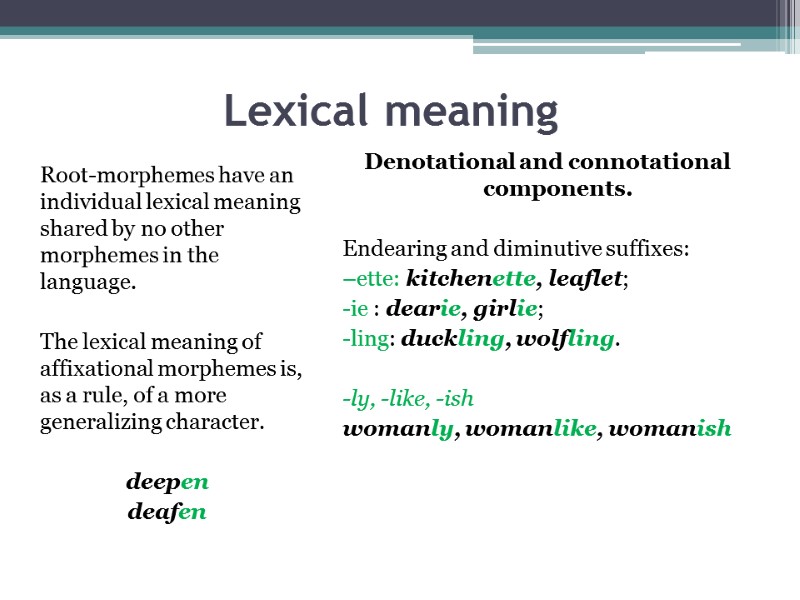
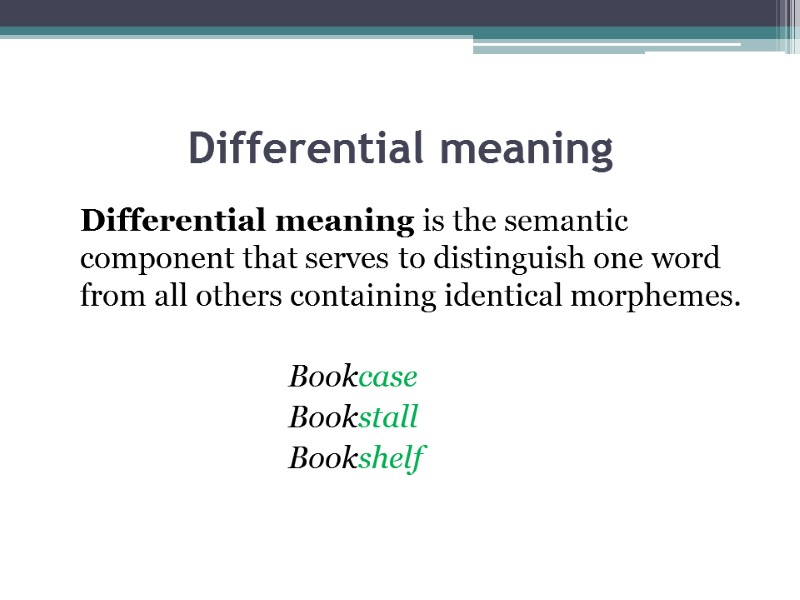
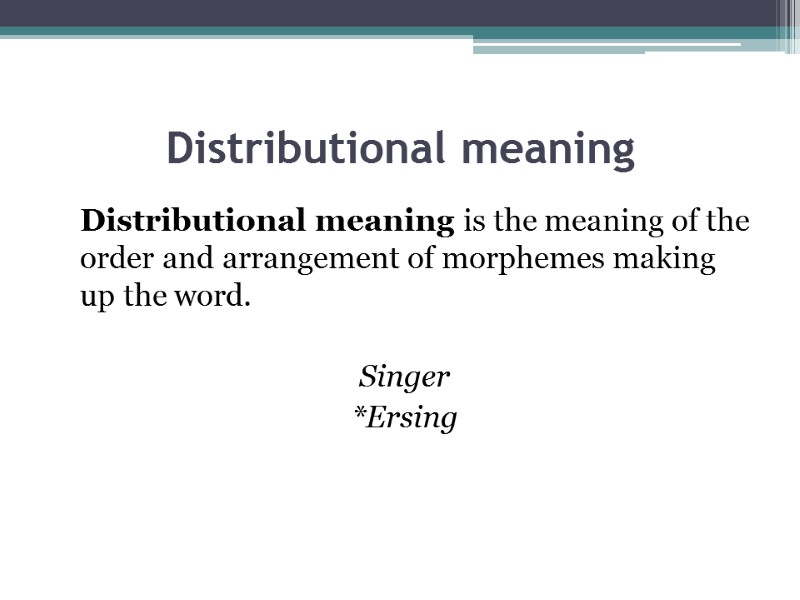
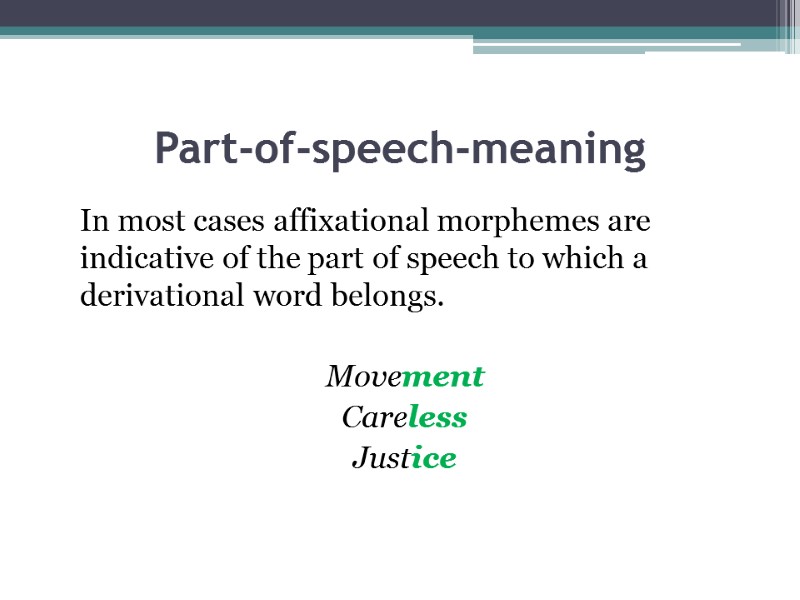
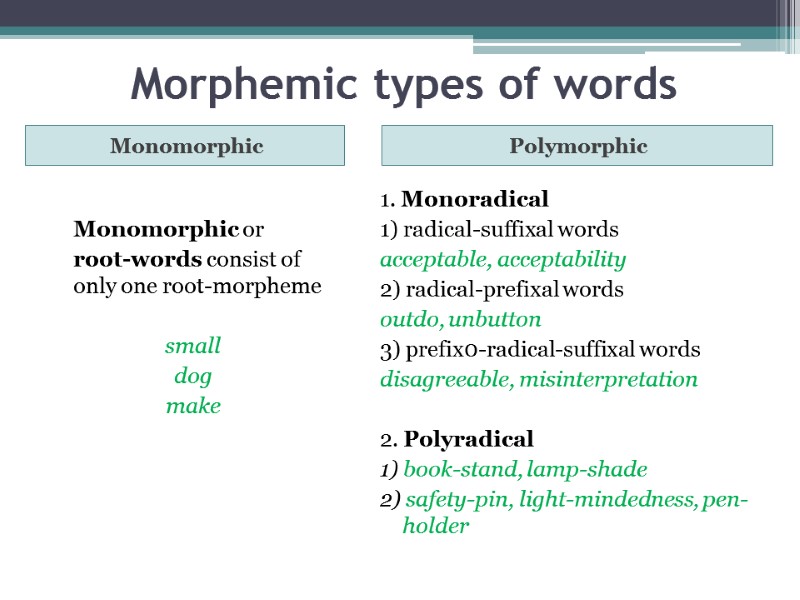
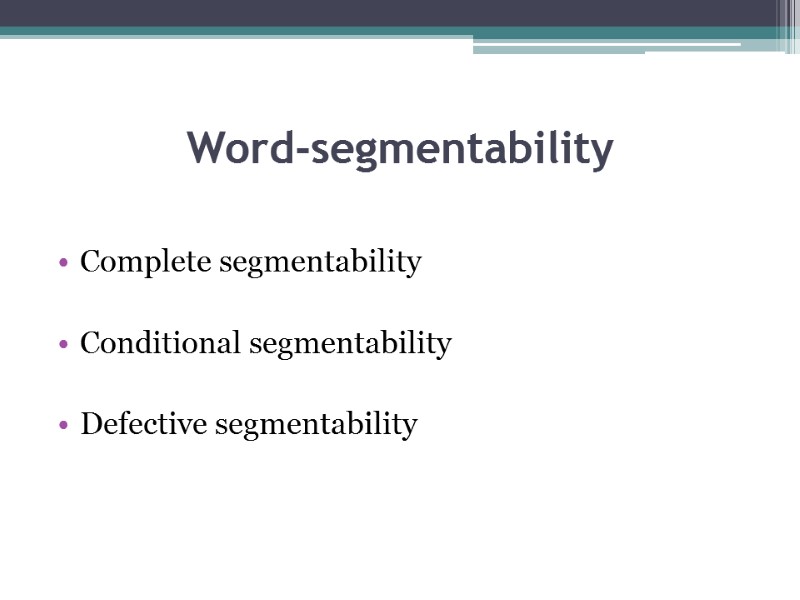
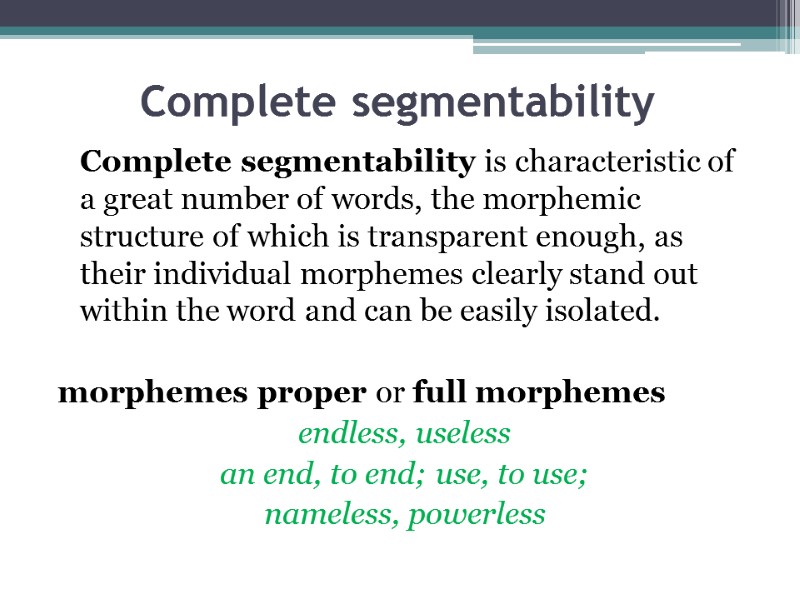

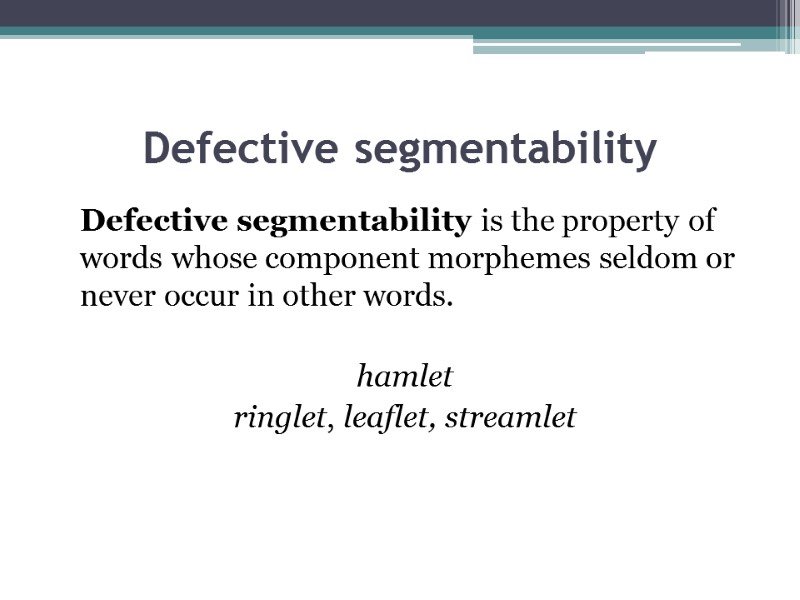
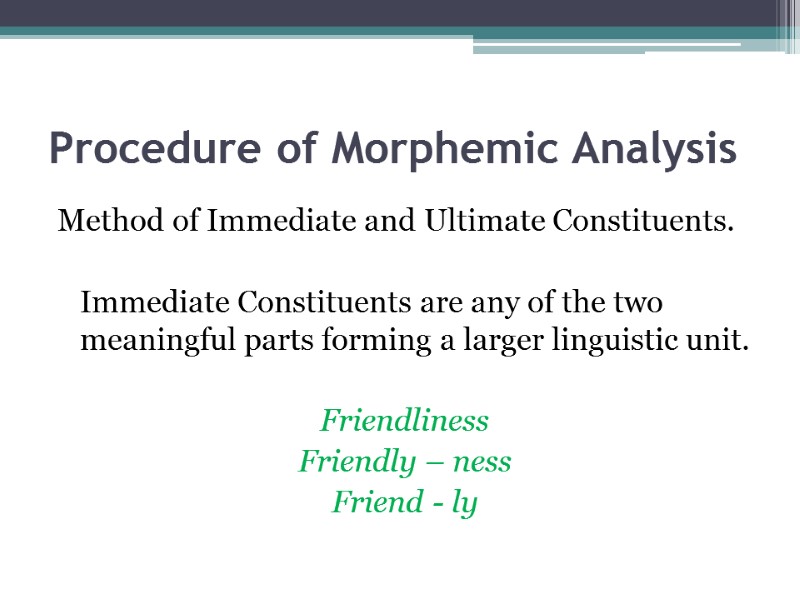
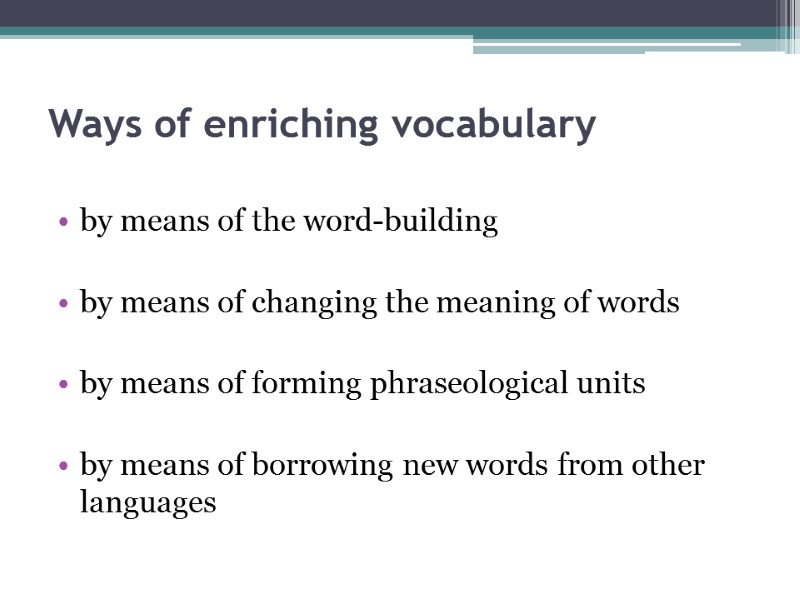
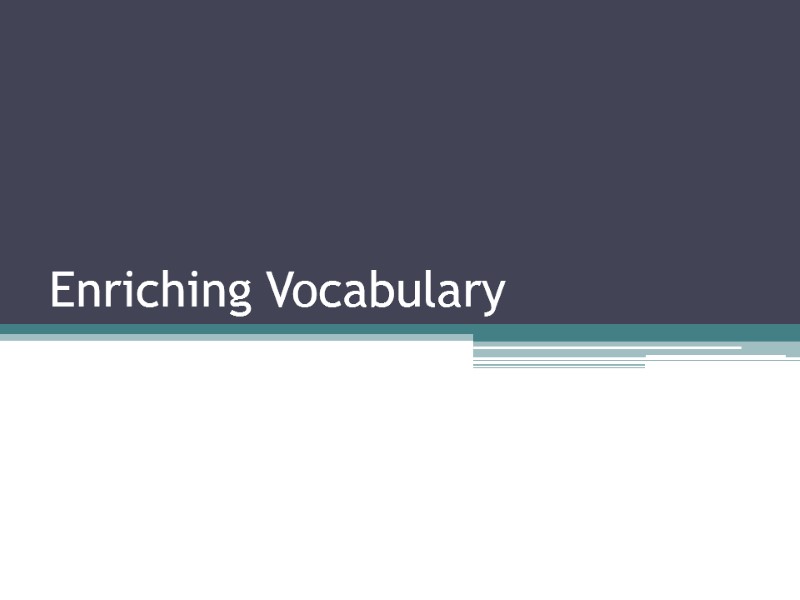

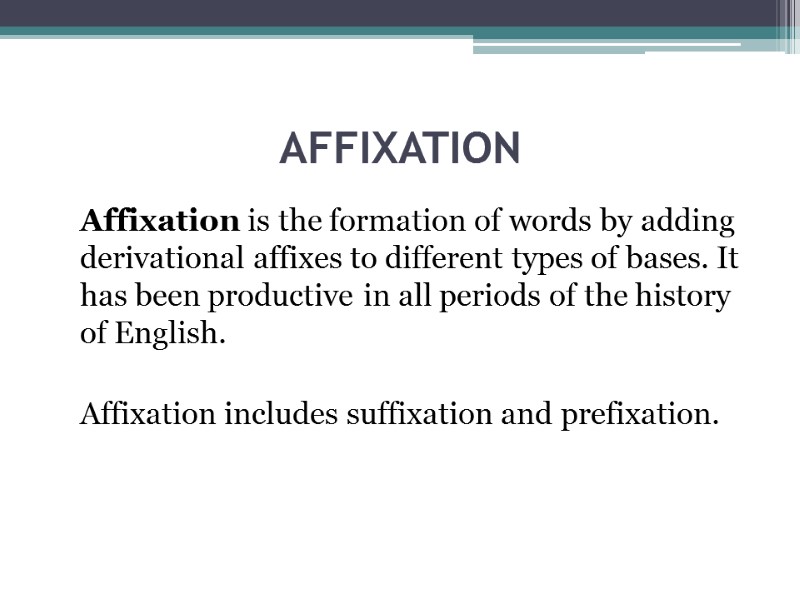
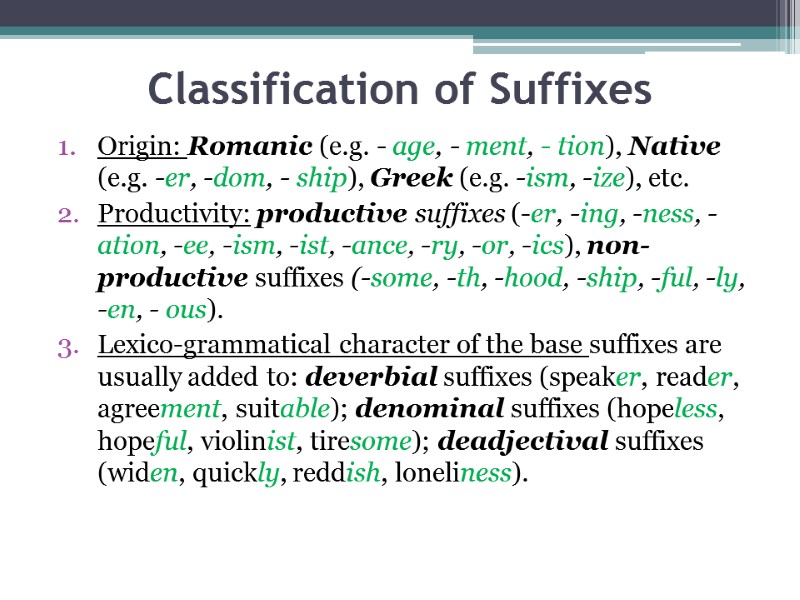
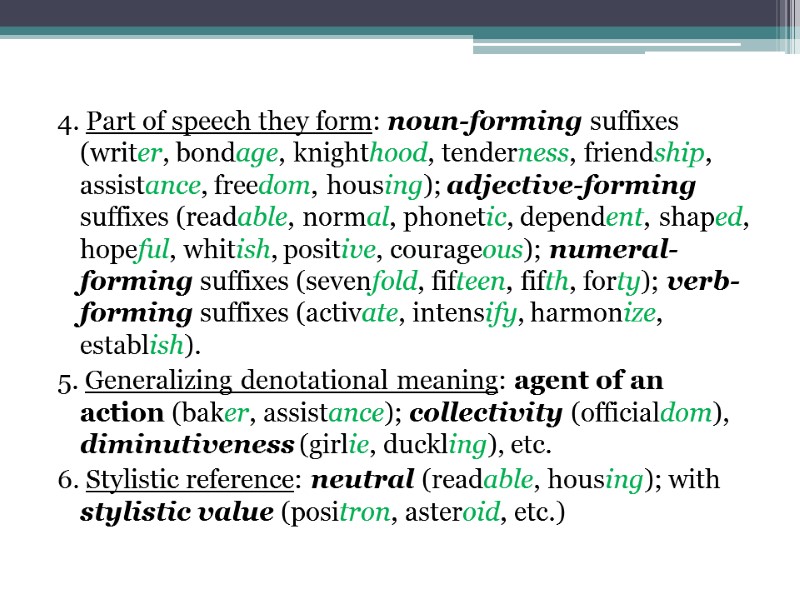
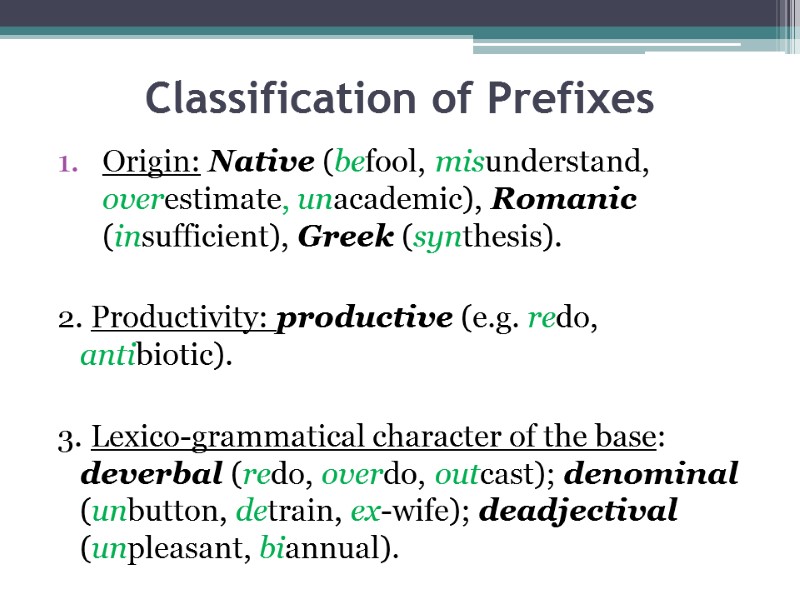
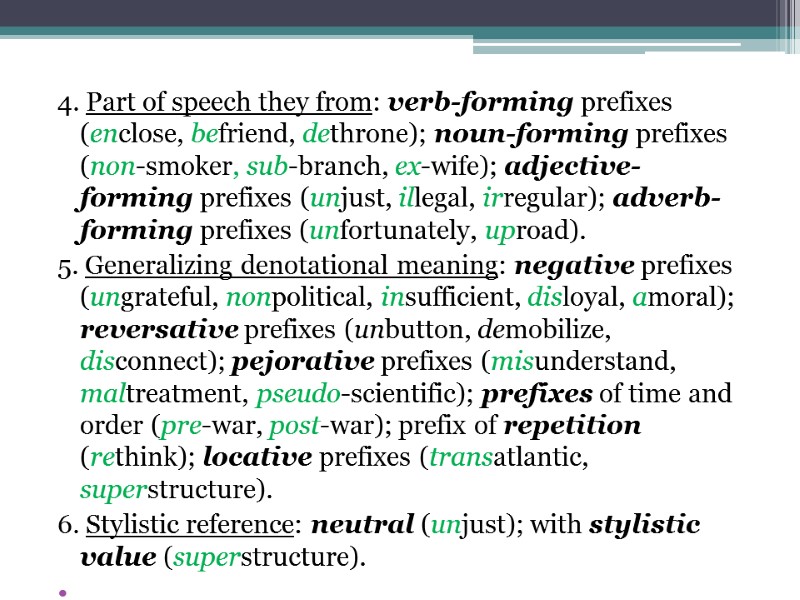
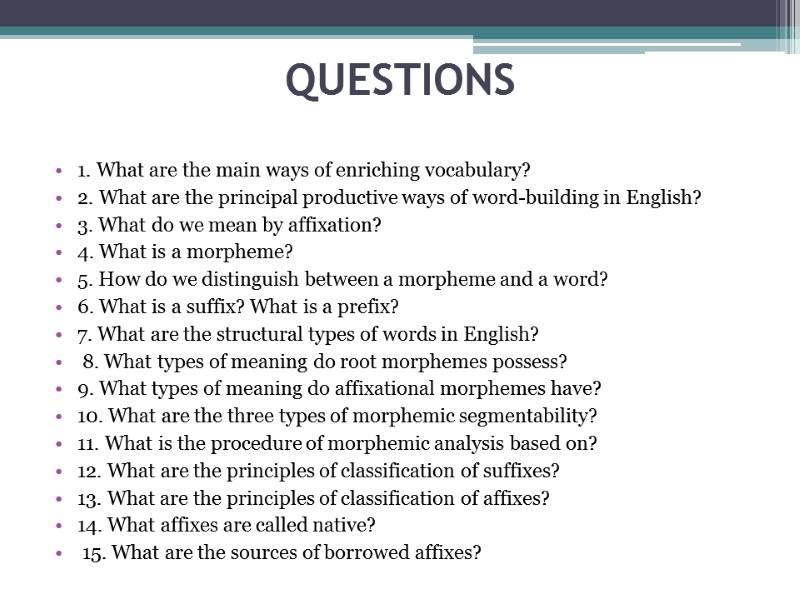
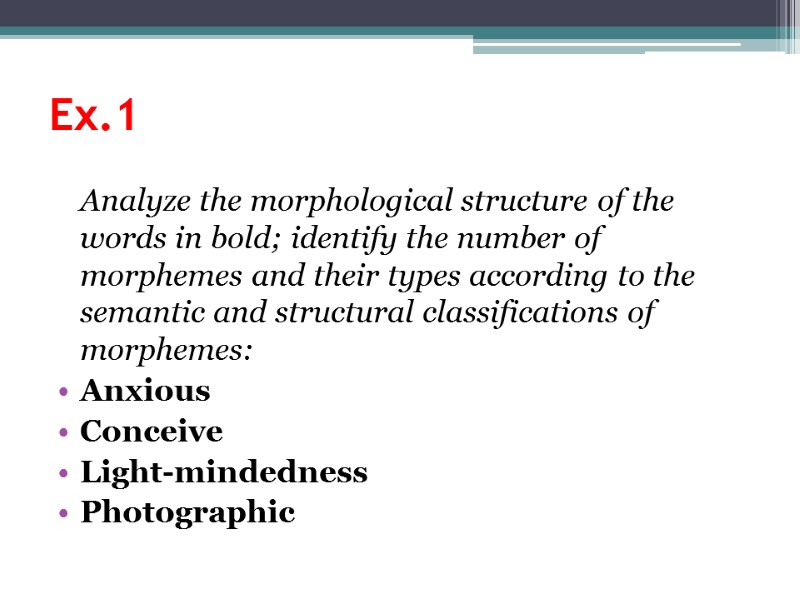
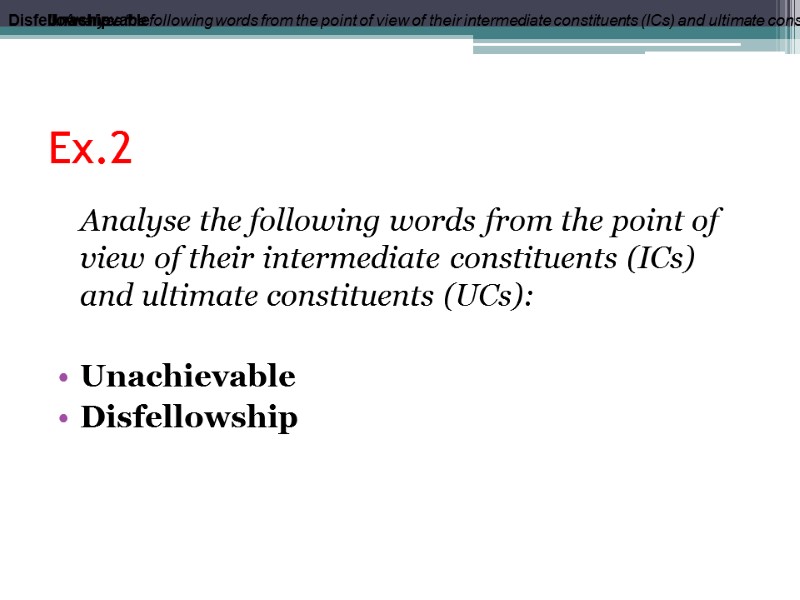

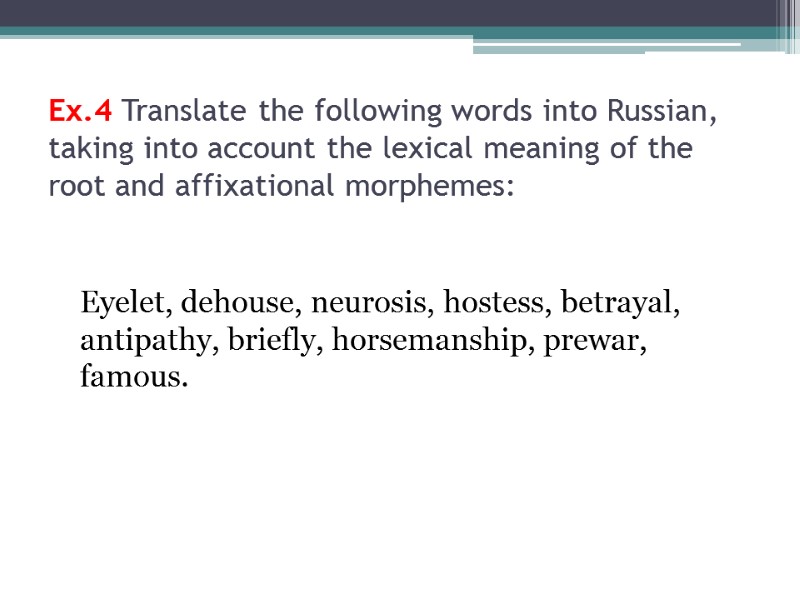
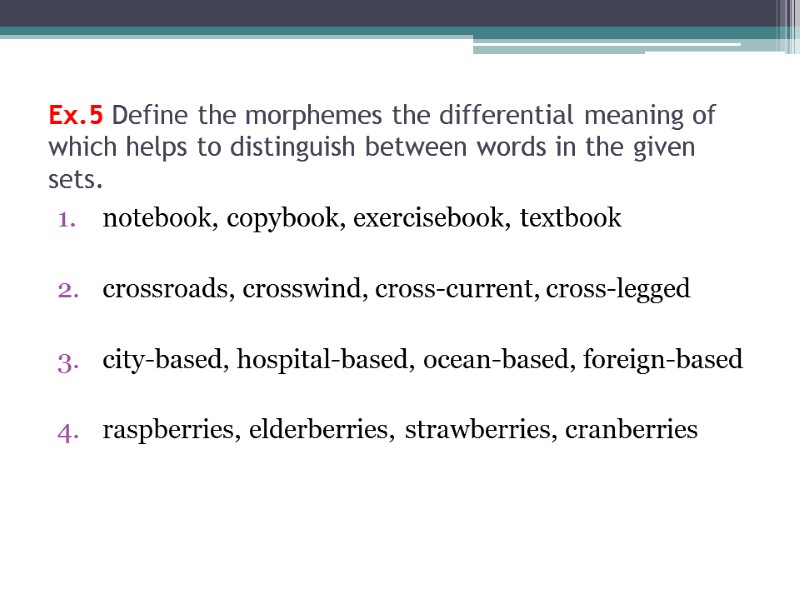
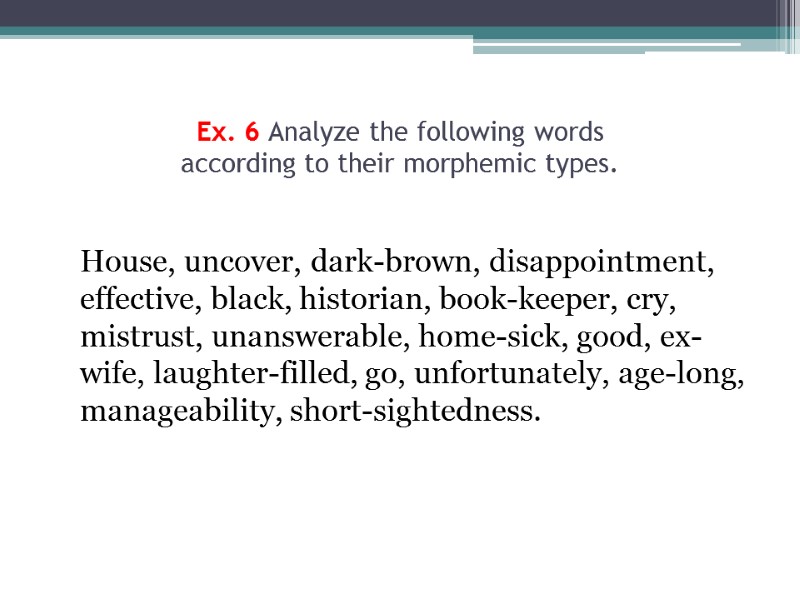
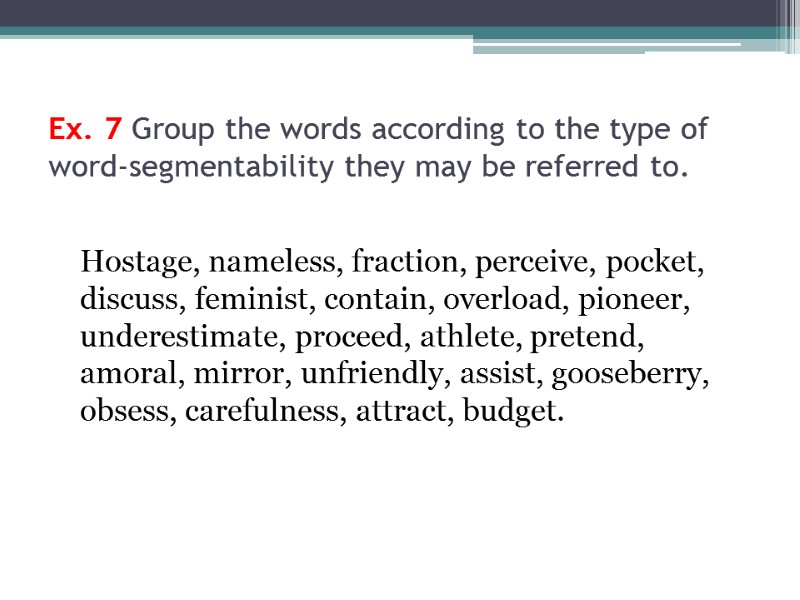
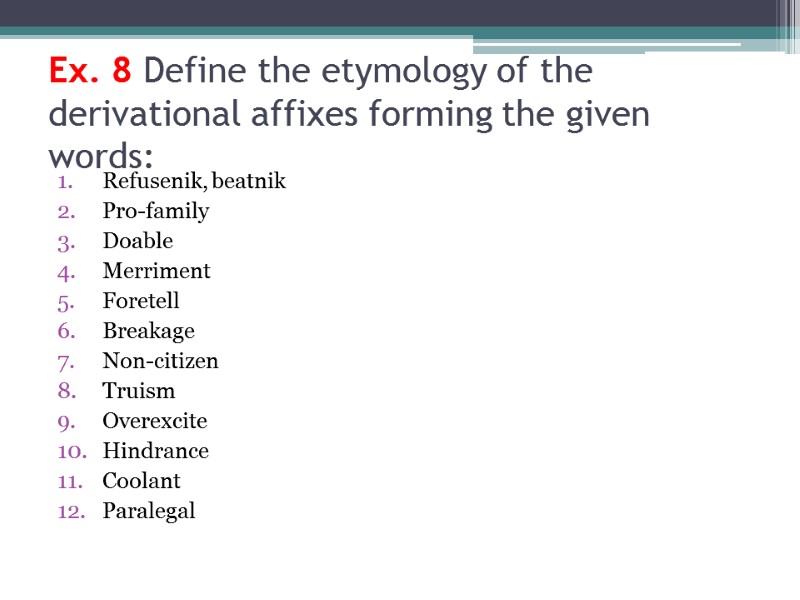
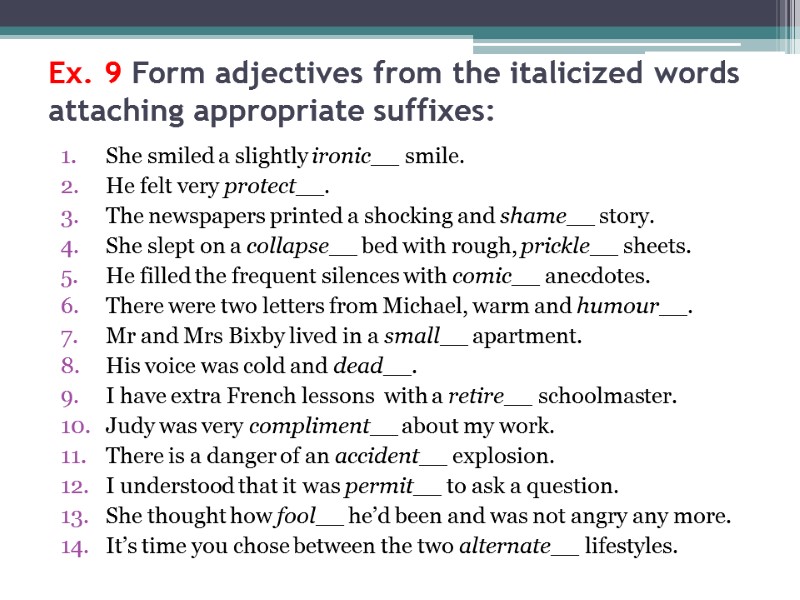
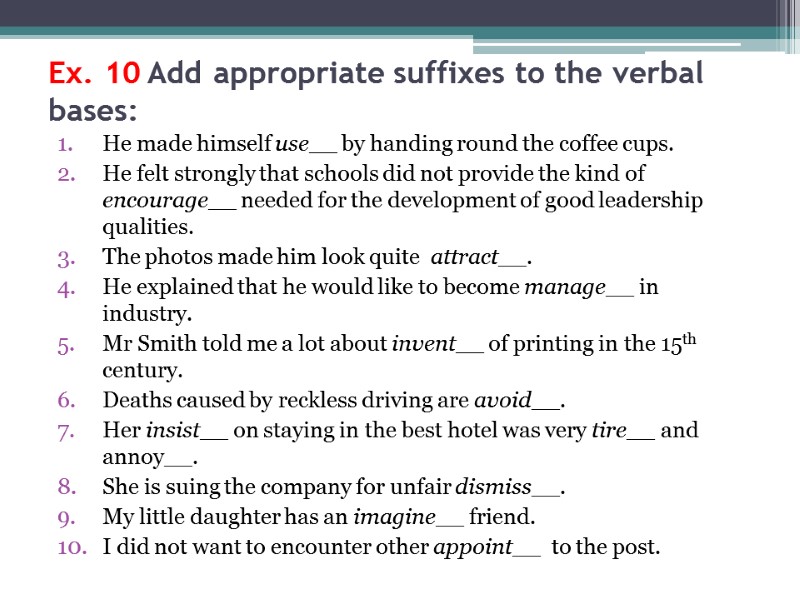

19682-lecture_2_morphemes_enriching_voc.ppt
- Количество слайдов: 37
 Morphemes. The Structure of the English Word Lecture 2
Morphemes. The Structure of the English Word Lecture 2
 Morpheme The morpheme is the smallest meaningful unit of form. The branch of linguistics which studies morphemes and their arrangement in forming words is called morphology. Morphemes cannot be segmented into smaller units without losing their constitutive essence. All the representations of the given morpheme are called allomorphs or morpheme variants (please, pleasing, pleasant, pleasure).
Morpheme The morpheme is the smallest meaningful unit of form. The branch of linguistics which studies morphemes and their arrangement in forming words is called morphology. Morphemes cannot be segmented into smaller units without losing their constitutive essence. All the representations of the given morpheme are called allomorphs or morpheme variants (please, pleasing, pleasant, pleasure).
 Semantically morphemes fall into two types: 1) Root-morphemes (or radicals) are the lexical nuclei of words. The root-morpheme is isolated as the morpheme common to a set of words making up a word-cluster, e.g. the morpheme teach- in to teach, teacher, teaching. 2) Non-root morphemes include inflectional morphemes (or inflections) and affixational morphemes (or affixes).
Semantically morphemes fall into two types: 1) Root-morphemes (or radicals) are the lexical nuclei of words. The root-morpheme is isolated as the morpheme common to a set of words making up a word-cluster, e.g. the morpheme teach- in to teach, teacher, teaching. 2) Non-root morphemes include inflectional morphemes (or inflections) and affixational morphemes (or affixes).
 Types of Morphemes The root expresses the lexical meaning of the word. Affixes modify the meaning of the root. Inflexions build new grammatical forms of the same words. The stem is the part of the word to which the latest suffix is added (it is the part of a word that remains unchanged throughout its paradigm): Active - act (root/stem) + ive (suffix) Activity – activ (stem) + ity (suffix)
Types of Morphemes The root expresses the lexical meaning of the word. Affixes modify the meaning of the root. Inflexions build new grammatical forms of the same words. The stem is the part of the word to which the latest suffix is added (it is the part of a word that remains unchanged throughout its paradigm): Active - act (root/stem) + ive (suffix) Activity – activ (stem) + ity (suffix)
 Affixes A prefix is a derivational morpheme preceding the root-morpheme and modifying its meaning (pronounce – mispronounce, safe – unsafe). A suffix is a derivational morpheme following the root and forming a new derivative in a different part of speech or a different word class (cf. –en, -y, -less, in hearten, hearty, heartless).
Affixes A prefix is a derivational morpheme preceding the root-morpheme and modifying its meaning (pronounce – mispronounce, safe – unsafe). A suffix is a derivational morpheme following the root and forming a new derivative in a different part of speech or a different word class (cf. –en, -y, -less, in hearten, hearty, heartless).
 Structurally morphemes fall into three types: 1) A free morpheme coincides with the stem or a word-form (boy). 2) A bound morpheme occurs only as a constituent part of the word (darkness, friendship, activize, impolite, demobilize). Pseudo-roots: gooseberry, conceive Combining forms: telephone, cyclic 3) Semi-bound (semi-free) morphemes are morphemes that can function in a morphemic sequence both as an affix and as a free morpheme (well and half in sleep well, half an hour; well-known, half-done).
Structurally morphemes fall into three types: 1) A free morpheme coincides with the stem or a word-form (boy). 2) A bound morpheme occurs only as a constituent part of the word (darkness, friendship, activize, impolite, demobilize). Pseudo-roots: gooseberry, conceive Combining forms: telephone, cyclic 3) Semi-bound (semi-free) morphemes are morphemes that can function in a morphemic sequence both as an affix and as a free morpheme (well and half in sleep well, half an hour; well-known, half-done).
 Types of meaning in morphemes Root-morphemes Affixational morphemes lexical meaning differential meaning distributional meaning lexical meaning part-of-speech meaning differential meaning distributional meaning
Types of meaning in morphemes Root-morphemes Affixational morphemes lexical meaning differential meaning distributional meaning lexical meaning part-of-speech meaning differential meaning distributional meaning
 Lexical meaning Root-morphemes have an individual lexical meaning shared by no other morphemes in the language. The lexical meaning of affixational morphemes is, as a rule, of a more generalizing character. deepen deafen Denotational and connotational components. Endearing and diminutive suffixes: –ette: kitchenette, leaflet; -ie : dearie, girlie; -ling: duckling, wolfling. -ly, -like, -ish womanly, womanlike, womanish
Lexical meaning Root-morphemes have an individual lexical meaning shared by no other morphemes in the language. The lexical meaning of affixational morphemes is, as a rule, of a more generalizing character. deepen deafen Denotational and connotational components. Endearing and diminutive suffixes: –ette: kitchenette, leaflet; -ie : dearie, girlie; -ling: duckling, wolfling. -ly, -like, -ish womanly, womanlike, womanish
 Differential meaning Differential meaning is the semantic component that serves to distinguish one word from all others containing identical morphemes. Bookcase Bookstall Bookshelf
Differential meaning Differential meaning is the semantic component that serves to distinguish one word from all others containing identical morphemes. Bookcase Bookstall Bookshelf
 Distributional meaning Distributional meaning is the meaning of the order and arrangement of morphemes making up the word. Singer *Ersing
Distributional meaning Distributional meaning is the meaning of the order and arrangement of morphemes making up the word. Singer *Ersing
 Part-of-speech-meaning In most cases affixational morphemes are indicative of the part of speech to which a derivational word belongs. Movement Careless Justice
Part-of-speech-meaning In most cases affixational morphemes are indicative of the part of speech to which a derivational word belongs. Movement Careless Justice
 Morphemic types of words Monomorphic Polymorphic Monomorphic or root-words consist of only one root-morpheme small dog make 1. Monoradical 1) radical-suffixal words acceptable, acceptability 2) radical-prefixal words outdo, unbutton 3) prefix0-radical-suffixal words disagreeable, misinterpretation 2. Polyradical 1) book-stand, lamp-shade 2) safety-pin, light-mindedness, pen-holder
Morphemic types of words Monomorphic Polymorphic Monomorphic or root-words consist of only one root-morpheme small dog make 1. Monoradical 1) radical-suffixal words acceptable, acceptability 2) radical-prefixal words outdo, unbutton 3) prefix0-radical-suffixal words disagreeable, misinterpretation 2. Polyradical 1) book-stand, lamp-shade 2) safety-pin, light-mindedness, pen-holder
 Word-segmentability Complete segmentability Conditional segmentability Defective segmentability
Word-segmentability Complete segmentability Conditional segmentability Defective segmentability
 Complete segmentability Complete segmentability is characteristic of a great number of words, the morphemic structure of which is transparent enough, as their individual morphemes clearly stand out within the word and can be easily isolated. morphemes proper or full morphemes endless, useless an end, to end; use, to use; nameless, powerless
Complete segmentability Complete segmentability is characteristic of a great number of words, the morphemic structure of which is transparent enough, as their individual morphemes clearly stand out within the word and can be easily isolated. morphemes proper or full morphemes endless, useless an end, to end; use, to use; nameless, powerless
 Conditional segmentabilty Conditional segmentabilty characterizes words whose segmentational morphemes is doubtful for semantic reasons. pseudo-morphemes or quasi-morphemes [ri-], [di-] [-tein], [-si:v] retain, detain, receive, deceive rewrite, reorganize, decode, deorganize. retain detain retain receive
Conditional segmentabilty Conditional segmentabilty characterizes words whose segmentational morphemes is doubtful for semantic reasons. pseudo-morphemes or quasi-morphemes [ri-], [di-] [-tein], [-si:v] retain, detain, receive, deceive rewrite, reorganize, decode, deorganize. retain detain retain receive
 Defective segmentability Defective segmentability is the property of words whose component morphemes seldom or never occur in other words. hamlet ringlet, leaflet, streamlet
Defective segmentability Defective segmentability is the property of words whose component morphemes seldom or never occur in other words. hamlet ringlet, leaflet, streamlet
 Procedure of Morphemic Analysis Method of Immediate and Ultimate Constituents. Immediate Constituents are any of the two meaningful parts forming a larger linguistic unit. Friendliness Friendly – ness Friend - ly
Procedure of Morphemic Analysis Method of Immediate and Ultimate Constituents. Immediate Constituents are any of the two meaningful parts forming a larger linguistic unit. Friendliness Friendly – ness Friend - ly
 Ways of enriching vocabulary by means of the word-building by means of changing the meaning of words by means of forming phraseological units by means of borrowing new words from other languages
Ways of enriching vocabulary by means of the word-building by means of changing the meaning of words by means of forming phraseological units by means of borrowing new words from other languages
 Enriching Vocabulary
Enriching Vocabulary
 Word-building Main ways of word-building Secondary ways of word-building Conversion Affixation Composition Shortening Blending (contamination) Sound interchange Stress interchange (distinctive stress) Sound imitation (onomatopoeia) Back formation (disaffixation)
Word-building Main ways of word-building Secondary ways of word-building Conversion Affixation Composition Shortening Blending (contamination) Sound interchange Stress interchange (distinctive stress) Sound imitation (onomatopoeia) Back formation (disaffixation)
 AFFIXATION Affixation is the formation of words by adding derivational affixes to different types of bases. It has been productive in all periods of the history of English. Affixation includes suffixation and prefixation.
AFFIXATION Affixation is the formation of words by adding derivational affixes to different types of bases. It has been productive in all periods of the history of English. Affixation includes suffixation and prefixation.
 Classification of Suffixes Origin: Romanic (e.g. - age, - ment, - tion), Native (e.g. -er, -dom, - ship), Greek (e.g. -ism, -ize), etc. Productivity: productive suffixes (-er, -ing, -ness, -ation, -ee, -ism, -ist, -ance, -ry, -or, -ics), non-productive suffixes (-some, -th, -hood, -ship, -ful, -ly, -en, - ous). Lexico-grammatical character of the base suffixes are usually added to: deverbial suffixes (speaker, reader, agreement, suitable); denominal suffixes (hopeless, hopeful, violinist, tiresome); deadjectival suffixes (widen, quickly, reddish, loneliness).
Classification of Suffixes Origin: Romanic (e.g. - age, - ment, - tion), Native (e.g. -er, -dom, - ship), Greek (e.g. -ism, -ize), etc. Productivity: productive suffixes (-er, -ing, -ness, -ation, -ee, -ism, -ist, -ance, -ry, -or, -ics), non-productive suffixes (-some, -th, -hood, -ship, -ful, -ly, -en, - ous). Lexico-grammatical character of the base suffixes are usually added to: deverbial suffixes (speaker, reader, agreement, suitable); denominal suffixes (hopeless, hopeful, violinist, tiresome); deadjectival suffixes (widen, quickly, reddish, loneliness).
 4. Part of speech they form: noun-forming suffixes (writer, bondage, knighthood, tenderness, friendship, assistance, freedom, housing); adjective-forming suffixes (readable, normal, phonetic, dependent, shaped, hopeful, whitish, positive, courageous); numeral-forming suffixes (sevenfold, fifteen, fifth, forty); verb-forming suffixes (activate, intensify, harmonize, establish). 5. Generalizing denotational meaning: agent of an action (baker, assistance); collectivity (officialdom), diminutiveness (girlie, duckling), etc. 6. Stylistic reference: neutral (readable, housing); with stylistic value (positron, asteroid, etc.)
4. Part of speech they form: noun-forming suffixes (writer, bondage, knighthood, tenderness, friendship, assistance, freedom, housing); adjective-forming suffixes (readable, normal, phonetic, dependent, shaped, hopeful, whitish, positive, courageous); numeral-forming suffixes (sevenfold, fifteen, fifth, forty); verb-forming suffixes (activate, intensify, harmonize, establish). 5. Generalizing denotational meaning: agent of an action (baker, assistance); collectivity (officialdom), diminutiveness (girlie, duckling), etc. 6. Stylistic reference: neutral (readable, housing); with stylistic value (positron, asteroid, etc.)
 Classification of Prefixes Origin: Native (befool, misunderstand, overestimate, unacademic), Romanic (insufficient), Greek (synthesis). 2. Productivity: productive (e.g. redo, antibiotic). 3. Lexico-grammatical character of the base: deverbal (redo, overdo, outcast); denominal (unbutton, detrain, ex-wife); deadjectival (unpleasant, biannual).
Classification of Prefixes Origin: Native (befool, misunderstand, overestimate, unacademic), Romanic (insufficient), Greek (synthesis). 2. Productivity: productive (e.g. redo, antibiotic). 3. Lexico-grammatical character of the base: deverbal (redo, overdo, outcast); denominal (unbutton, detrain, ex-wife); deadjectival (unpleasant, biannual).
 4. Part of speech they from: verb-forming prefixes (enclose, befriend, dethrone); noun-forming prefixes (non-smoker, sub-branch, ex-wife); adjective-forming prefixes (unjust, illegal, irregular); adverb-forming prefixes (unfortunately, uproad). 5. Generalizing denotational meaning: negative prefixes (ungrateful, nonpolitical, insufficient, disloyal, amoral); reversative prefixes (unbutton, demobilize, disconnect); pejorative prefixes (misunderstand, maltreatment, pseudo-scientific); prefixes of time and order (pre-war, post-war); prefix of repetition (rethink); locative prefixes (transatlantic, superstructure). 6. Stylistic reference: neutral (unjust); with stylistic value (superstructure).
4. Part of speech they from: verb-forming prefixes (enclose, befriend, dethrone); noun-forming prefixes (non-smoker, sub-branch, ex-wife); adjective-forming prefixes (unjust, illegal, irregular); adverb-forming prefixes (unfortunately, uproad). 5. Generalizing denotational meaning: negative prefixes (ungrateful, nonpolitical, insufficient, disloyal, amoral); reversative prefixes (unbutton, demobilize, disconnect); pejorative prefixes (misunderstand, maltreatment, pseudo-scientific); prefixes of time and order (pre-war, post-war); prefix of repetition (rethink); locative prefixes (transatlantic, superstructure). 6. Stylistic reference: neutral (unjust); with stylistic value (superstructure).
 QUESTIONS 1. What are the main ways of enriching vocabulary? 2. What are the principal productive ways of word-building in English? 3. What do we mean by affixation? 4. What is a morpheme? 5. How do we distinguish between a morpheme and a word? 6. What is a suffix? What is a prefix? 7. What are the structural types of words in English? 8. What types of meaning do root morphemes possess? 9. What types of meaning do affixational morphemes have? 10. What are the three types of morphemic segmentability? 11. What is the procedure of morphemic analysis based on? 12. What are the principles of classification of suffixes? 13. What are the principles of classification of affixes? 14. What affixes are called native? 15. What are the sources of borrowed affixes?
QUESTIONS 1. What are the main ways of enriching vocabulary? 2. What are the principal productive ways of word-building in English? 3. What do we mean by affixation? 4. What is a morpheme? 5. How do we distinguish between a morpheme and a word? 6. What is a suffix? What is a prefix? 7. What are the structural types of words in English? 8. What types of meaning do root morphemes possess? 9. What types of meaning do affixational morphemes have? 10. What are the three types of morphemic segmentability? 11. What is the procedure of morphemic analysis based on? 12. What are the principles of classification of suffixes? 13. What are the principles of classification of affixes? 14. What affixes are called native? 15. What are the sources of borrowed affixes?
 Ex.1 Analyze the morphological structure of the words in bold; identify the number of morphemes and their types according to the semantic and structural classifications of morphemes: Anxious Conceive Light-mindedness Photographic
Ex.1 Analyze the morphological structure of the words in bold; identify the number of morphemes and their types according to the semantic and structural classifications of morphemes: Anxious Conceive Light-mindedness Photographic
 Ex.2 Analyse the following words from the point of view of their intermediate constituents (ICs) and ultimate constituents (UCs): Unachievable Disfellowship II. Analyse the following words from the point of view of their intermediate constituents (ICs) and ultimate constituents (UCs): Unachievable Disfellowship
Ex.2 Analyse the following words from the point of view of their intermediate constituents (ICs) and ultimate constituents (UCs): Unachievable Disfellowship II. Analyse the following words from the point of view of their intermediate constituents (ICs) and ultimate constituents (UCs): Unachievable Disfellowship
 Ex.3. Segment the following words into morphemes. Define the semantic types and the structural types of morphemes. Beggarly, postman, shorten, destabilize, sympathy, fruitfulness, maltreatment, disaffected, overrule, photographic, half-eaten, theory, rent-free.
Ex.3. Segment the following words into morphemes. Define the semantic types and the structural types of morphemes. Beggarly, postman, shorten, destabilize, sympathy, fruitfulness, maltreatment, disaffected, overrule, photographic, half-eaten, theory, rent-free.
 Ex.4 Translate the following words into Russian, taking into account the lexical meaning of the root and affixational morphemes: Eyelet, dehouse, neurosis, hostess, betrayal, antipathy, briefly, horsemanship, prewar, famous.
Ex.4 Translate the following words into Russian, taking into account the lexical meaning of the root and affixational morphemes: Eyelet, dehouse, neurosis, hostess, betrayal, antipathy, briefly, horsemanship, prewar, famous.
 Ex.5 Define the morphemes the differential meaning of which helps to distinguish between words in the given sets. notebook, copybook, exercisebook, textbook crossroads, crosswind, cross-current, cross-legged city-based, hospital-based, ocean-based, foreign-based raspberries, elderberries, strawberries, cranberries
Ex.5 Define the morphemes the differential meaning of which helps to distinguish between words in the given sets. notebook, copybook, exercisebook, textbook crossroads, crosswind, cross-current, cross-legged city-based, hospital-based, ocean-based, foreign-based raspberries, elderberries, strawberries, cranberries
 Ex. 6 Analyze the following words according to their morphemic types. House, uncover, dark-brown, disappointment, effective, black, historian, book-keeper, cry, mistrust, unanswerable, home-sick, good, ex-wife, laughter-filled, go, unfortunately, age-long, manageability, short-sightedness.
Ex. 6 Analyze the following words according to their morphemic types. House, uncover, dark-brown, disappointment, effective, black, historian, book-keeper, cry, mistrust, unanswerable, home-sick, good, ex-wife, laughter-filled, go, unfortunately, age-long, manageability, short-sightedness.
 Ex. 7 Group the words according to the type of word-segmentability they may be referred to. Hostage, nameless, fraction, perceive, pocket, discuss, feminist, contain, overload, pioneer, underestimate, proceed, athlete, pretend, amoral, mirror, unfriendly, assist, gooseberry, obsess, carefulness, attract, budget.
Ex. 7 Group the words according to the type of word-segmentability they may be referred to. Hostage, nameless, fraction, perceive, pocket, discuss, feminist, contain, overload, pioneer, underestimate, proceed, athlete, pretend, amoral, mirror, unfriendly, assist, gooseberry, obsess, carefulness, attract, budget.
 Ex. 8 Define the etymology of the derivational affixes forming the given words: Refusenik, beatnik Pro-family Doable Merriment Foretell Breakage Non-citizen Truism Overexcite Hindrance Coolant Paralegal
Ex. 8 Define the etymology of the derivational affixes forming the given words: Refusenik, beatnik Pro-family Doable Merriment Foretell Breakage Non-citizen Truism Overexcite Hindrance Coolant Paralegal
 Ex. 9 Form adjectives from the italicized words attaching appropriate suffixes: She smiled a slightly ironic__ smile. He felt very protect__. The newspapers printed a shocking and shame__ story. She slept on a collapse__ bed with rough, prickle__ sheets. He filled the frequent silences with comic__ anecdotes. There were two letters from Michael, warm and humour__. Mr and Mrs Bixby lived in a small__ apartment. His voice was cold and dead__. I have extra French lessons with a retire__ schoolmaster. Judy was very compliment__ about my work. There is a danger of an accident__ explosion. I understood that it was permit__ to ask a question. She thought how fool__ he’d been and was not angry any more. It’s time you chose between the two alternate__ lifestyles.
Ex. 9 Form adjectives from the italicized words attaching appropriate suffixes: She smiled a slightly ironic__ smile. He felt very protect__. The newspapers printed a shocking and shame__ story. She slept on a collapse__ bed with rough, prickle__ sheets. He filled the frequent silences with comic__ anecdotes. There were two letters from Michael, warm and humour__. Mr and Mrs Bixby lived in a small__ apartment. His voice was cold and dead__. I have extra French lessons with a retire__ schoolmaster. Judy was very compliment__ about my work. There is a danger of an accident__ explosion. I understood that it was permit__ to ask a question. She thought how fool__ he’d been and was not angry any more. It’s time you chose between the two alternate__ lifestyles.
 Ex. 10 Add appropriate suffixes to the verbal bases: He made himself use__ by handing round the coffee cups. He felt strongly that schools did not provide the kind of encourage__ needed for the development of good leadership qualities. The photos made him look quite attract__. He explained that he would like to become manage__ in industry. Mr Smith told me a lot about invent__ of printing in the 15th century. Deaths caused by reckless driving are avoid__. Her insist__ on staying in the best hotel was very tire__ and annoy__. She is suing the company for unfair dismiss__. My little daughter has an imagine__ friend. I did not want to encounter other appoint__ to the post.
Ex. 10 Add appropriate suffixes to the verbal bases: He made himself use__ by handing round the coffee cups. He felt strongly that schools did not provide the kind of encourage__ needed for the development of good leadership qualities. The photos made him look quite attract__. He explained that he would like to become manage__ in industry. Mr Smith told me a lot about invent__ of printing in the 15th century. Deaths caused by reckless driving are avoid__. Her insist__ on staying in the best hotel was very tire__ and annoy__. She is suing the company for unfair dismiss__. My little daughter has an imagine__ friend. I did not want to encounter other appoint__ to the post.


